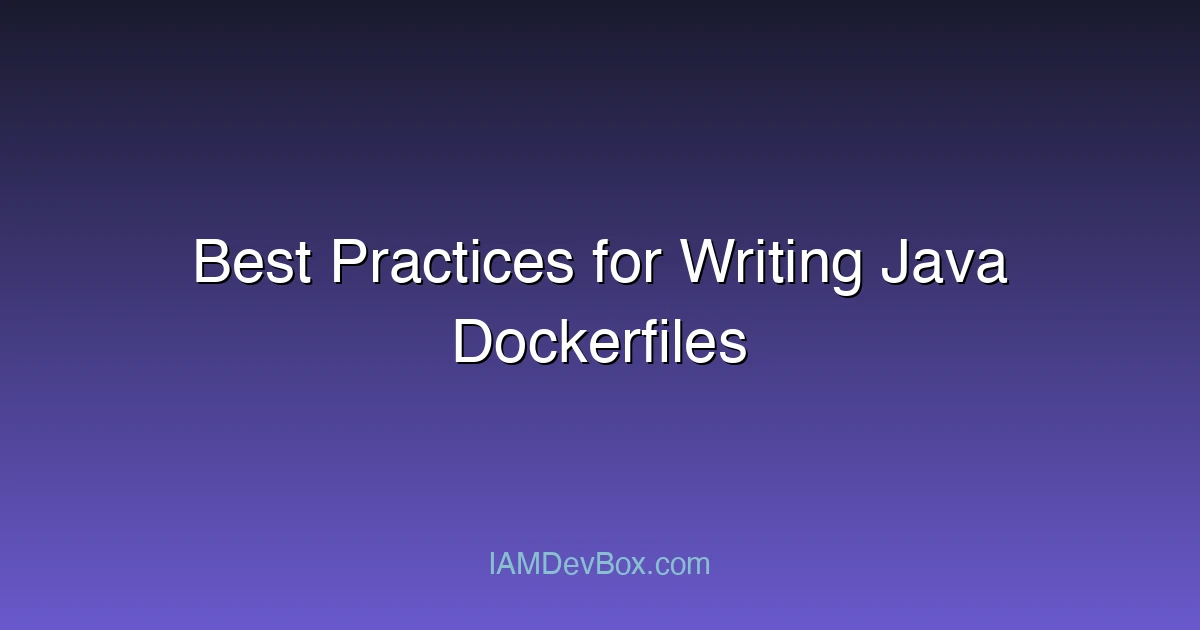Docker has become a cornerstone of modern software development, enabling developers to package applications and their dependencies into lightweight, portable containers. For Java applications, writing an efficient and secure Dockerfile is crucial to ensure optimal performance, scalability, and maintainability. This blog post explores best practices for writing Java Dockerfiles, covering everything from minimizing image size to optimizing resource usage.
1. Use a Minimal Base Image
The foundation of any Dockerfile is the base image. For Java applications, it’s essential to choose a base image that is both lightweight and secure. The Eclipse Temurin or AdoptOpenJDK images are excellent choices, as they are optimized for Java applications and regularly updated.
Example: Minimal Base Image
# Use a minimal base image with the required JDK version
FROM eclipse-temurin:17-jdk-jammy
# Set the working directory
WORKDIR /app
# Copy the application JAR file
COPY target/my-java-app.jar .
# Expose the application port
EXPOSE 8080
# Define the command to run the application
CMD ["java", "-jar", "my-java-app.jar"]
Explanation:
This Dockerfile starts with a minimal base image (eclipse-temurin:17-jdk-jammy), which includes only the necessary components for running a Java application. By avoiding bloated images, you reduce the attack surface and improve performance.
2. Optimize for Multi-Stage Builds
Multi-stage builds are a powerful feature of Docker that allow you to separate the build environment from the runtime environment. This approach minimizes the final image size by discarding unnecessary build tools and dependencies.
Example: Multi-Stage Build
# Stage 1: Build the application
FROM maven:3.8.6-eclipse-temurin-17-jdk AS builder
WORKDIR /app
COPY src src
COPY pom.xml .
RUN mvn clean package -DskipTests
# Stage 2: Runtime environment
FROM eclipse-temurin:17-jdk-jammy
WORKDIR /app
COPY --from=builder /app/target/my-java-app.jar .
EXPOSE 8080
CMD ["java", "-jar", "my-java-app.jar"]
Explanation: In this example, the first stage uses a Maven image to build the Java application. The second stage uses a minimal JDK image and copies only the JAR file from the first stage. This reduces the final image size and improves security by removing build tools.
3. Configure Environment Variables Properly
Environment variables are essential for configuring applications at runtime. They allow you to decouple configuration from code and adapt the application to different environments (e.g., development, testing, production).
Example: Setting Environment Variables
# Set environment variables
ENV JAVA_OPTS="-Xmx512m -Xms256m -XX:+UseG1GC"
ENV APP_ENV="production"
ENV DB_URL="jdbc:mysql://database:3306/mydb"
# Run the application with the configured options
CMD ["java",
<div class="notice warning">⚠️ <strong>Important:</strong> The `JAVA_OPTS` variable configures JVM memory settings and garbage collection. The `APP_ENV` and `DB_URL` variables provide runtime configuration for the application. Using environment variables ensures flexibility and avoids hardcoding sensitive information.</div>
"-jar", "my-java-app.jar"]
Explanation:
The JAVA_OPTS variable configures JVM memory settings and garbage collection. The APP_ENV and DB_URL variables provide runtime configuration for the application. Using environment variables ensures flexibility and avoids hardcoding sensitive information.
4. Leverage Docker Build Caching
Docker’s build caching mechanism can significantly speed up the build process by reusing previously built layers. To take full advantage of this, organize your Dockerfile to place frequently changing instructions (e.g., COPY) after less frequently changing instructions (e.g., RUN).
Example: Optimizing Build Caching
# Place frequently changing instructions at the end
FROM eclipse-temurin:17-jdk-jammy
WORKDIR /app
# Install system dependencies
RUN apt-get update && apt-get install -y \
curl \
&& rm -rf /var/lib/apt/lists/*
# Copy only the JAR file at the end
COPY target/my-java-app.jar .
EXPOSE 8080
CMD ["java", "-jar", "my-java-app.jar"]
Explanation:
By placing the COPY instruction at the end, you ensure that Docker only rebuilds this layer when the JAR file changes. This reduces build time and improves efficiency.
5. Implement Resource Limits and Constraints
Java applications can be resource-intensive, especially in production environments. Docker allows you to set resource limits (e.g., CPU, memory) to prevent a single container from monopolizing system resources.
Example: Setting Resource Limits
# Set memory limits
ENV JAVA_OPTS="-Xmx512m -Xms256m"
# Run the application
CMD ["java", "-jar", "my-java-app.jar"]
Explanation:
The JAVA_OPTS variable sets the maximum and initial heap sizes for the JVM. This ensures that the application doesn’t consume excessive memory, which could destabilize the host system or other containers.
6. Follow Security Best Practices
Security is a critical consideration when building Docker images. Java applications are often targets for attacks due to their widespread use and potential vulnerabilities.
Example: Securing the Image
# Use a non-root user
RUN groupadd -g 1000 appuser && useradd -u 1000 -g appuser appuser
# Switch to the non-root user
USER appuser
# Copy the JAR file to the user's directory
COPY --chown=appuser:appuser target/my-java-app.jar .
# Run the application with reduced privileges
CMD ["java", "-jar", "my-java-app.jar"]
Explanation:
This Dockerfile creates a non-root user (appuser) and switches to it before running the application. By avoiding running containers as root, you reduce the risk of privilege escalation attacks.
7. Test and Debug Locally
Before deploying your Java application to production, it’s essential to test it locally using Docker. This allows you to identify and fix issues early in the development cycle.
